Semiconductor manufacturer Vishay Intertechnology (NYSE:VSH) reported Q1 CY2024 results exceeding Wall Street analysts' expectations, with revenue down 14.3% year on year to $746.3 million. On the other hand, next quarter's revenue guidance of $750 million was less impressive, coming in 1.3% below analysts' estimates. It made a GAAP profit of $0.22 per share, down from its profit of $0.79 per share in the same quarter last year.
Vishay Intertechnology (VSH) Q1 CY2024 Highlights:
- Revenue: $746.3 million vs analyst estimates of $735.9 million (1.4% beat)
- EPS: $0.22 vs analyst estimates of $0.21 (4.8% beat)
- Revenue Guidance for Q2 CY2024 is $750 million at the midpoint, below analyst estimates of $759.5 million
- Gross Margin (GAAP): 22.8%, down from 32% in the same quarter last year
- Inventory Days Outstanding: 105, up from 101 in the previous quarter
- Free Cash Flow of $27.88 million is up from -$138.9 million in the previous quarter
- Market Capitalization: $3.16 billion
Named after the founder's ancestral village in present-day Lithuania, Vishay Intertechnology (NYSE:VSH) manufactures simple chips and electronic components that are building blocks of virtually all types of electronic devices.
Vishay mainly manufactures discrete semiconductors and passive electronic components that can be found in almost any electronic device. Discrete semiconductors are chips that have a small number of transistors and are used for basic functions. Discrete semiconductors essentially exist in an on or off state and function alongside more complex chips in virtually every electronic device. The company also manufactures passive electronic devices such as resistors, inductors, and capacitors. These components are essential for the operation of electronic devices and work in tandem with more complex parts from other manufacturers. Through the manufacturing of discrete semiconductors and passive electronic components, Vishay is essentially supplying the most basic elements of any electronic device.Vishay’s peers and competitors include Analog Devices (NASDAQ: ADI) Texas Instruments (NASDAQ: TXN), Skyworks (NASDAQ:SWKS), Infineon (XTRA:IFX), NXP Semiconductors NV (NASDAQ:NXPI), ON Semi (NASDAQ:ON), Marvell Technology (NASDAQ:MRVL), and Microchip (NASDAQ:MCHP).Sales Growth
Vishay Intertechnology's revenue growth over the last three years has been unremarkable, averaging 8.5% annually. This quarter, its revenue declined from $871 million in the same quarter last year to $746.3 million. Semiconductors are a cyclical industry, and long-term investors should be prepared for periods of high growth followed by periods of revenue contractions (which can sometimes offer opportune times to buy).
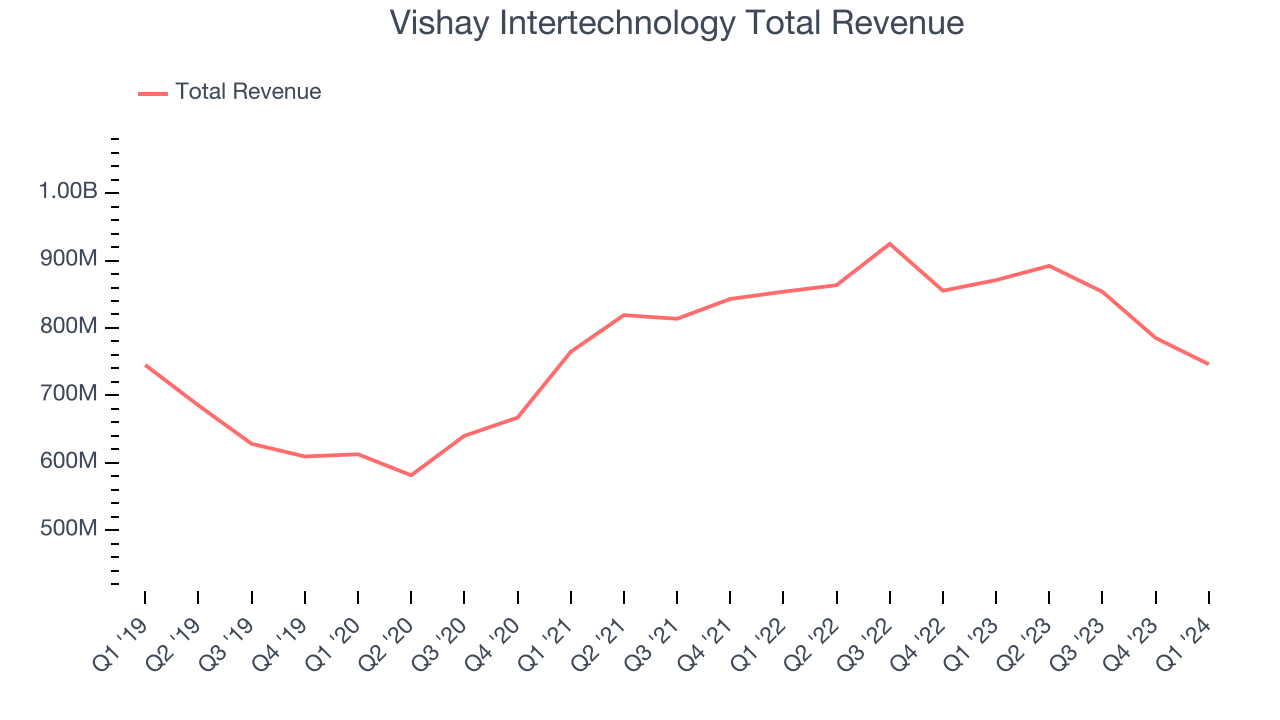
Even though Vishay Intertechnology surpassed analysts' revenue estimates, this was a slow quarter for the company as its revenue dropped 14.3% year on year. This could mean that the current downcycle is deepening.
Vishay Intertechnology's revenue growth has decelerated over the last three quarters and its management team projects revenue to fall next quarter. As such, the company is guiding for a 15.9% year-on-year revenue decline while analysts are expecting a 4.3% drop over the next 12 months.
Product Demand & Outstanding Inventory
Days Inventory Outstanding (DIO) is an important metric for chipmakers, as it reflects a business' capital intensity and the cyclical nature of semiconductor supply and demand. In a tight supply environment, inventories tend to be stable, allowing chipmakers to exert pricing power. Steadily increasing DIO can be a warning sign that demand is weak, and if inventories continue to rise, the company may have to downsize production.
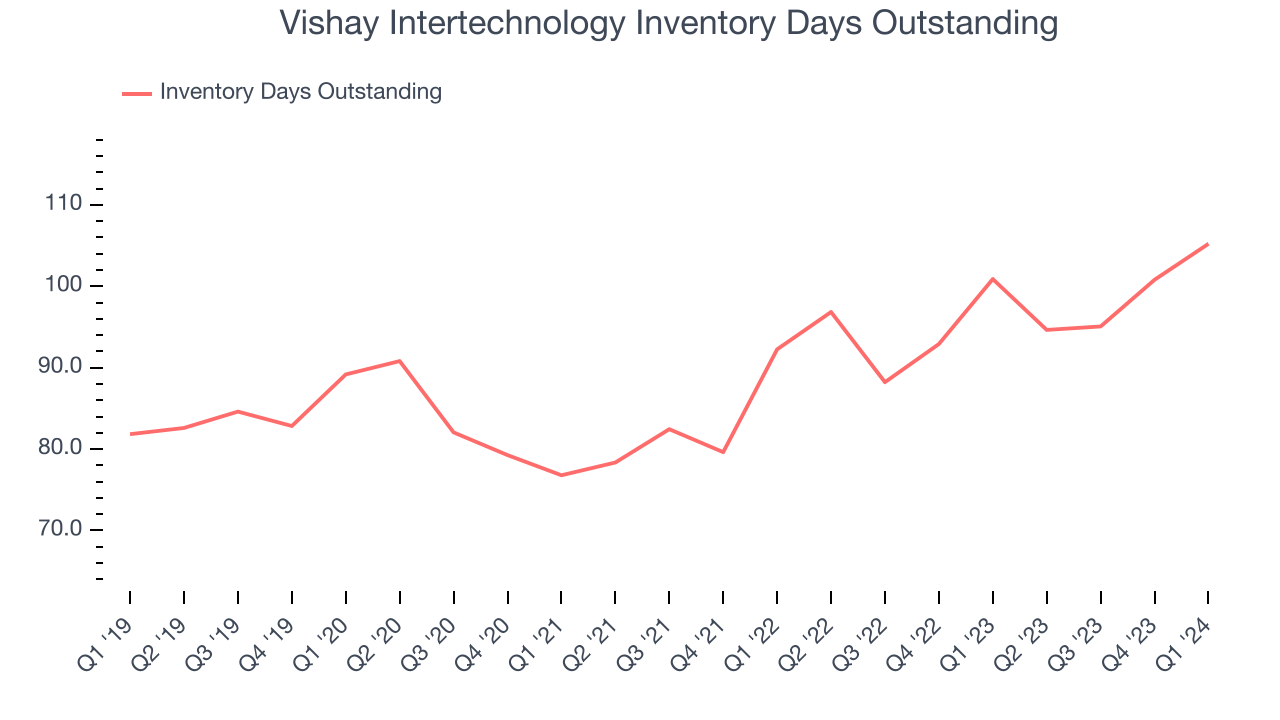
This quarter, Vishay Intertechnology's DIO came in at 105, which is 16 days above its five-year average, suggesting that the company's inventory has grown to higher levels than we've seen in the past.
Pricing Power
In the semiconductor industry, a company's gross profit margin is a critical metric to track because it sheds light on its pricing power, complexity of products, and ability to procure raw materials, equipment, and labor. Vishay Intertechnology's gross profit margin, which shows how much money the company gets to keep after paying key materials, input, and manufacturing costs, came in at 22.8% in Q1, down 9.2 percentage points year on year.
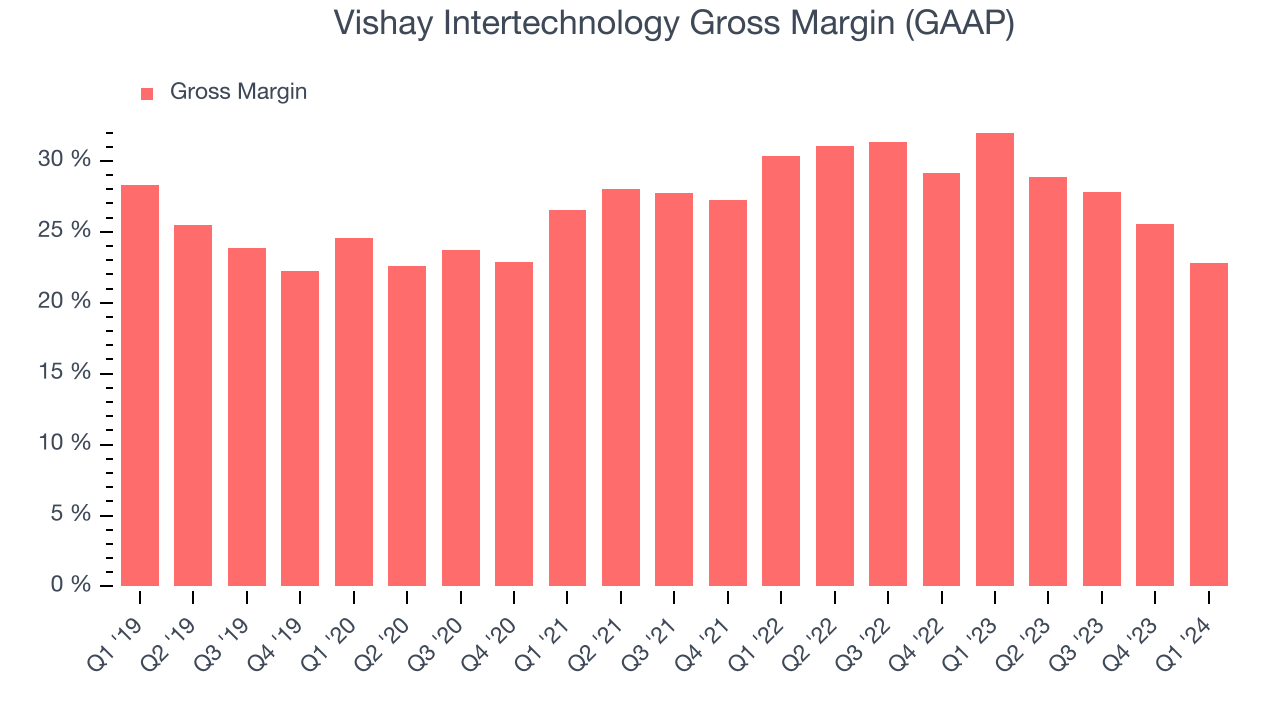
Vishay Intertechnology's gross margins have been trending down over the last 12 months, averaging 26.4%. This weakness isn't great as Vishay Intertechnology's margins are already far below other semiconductor companies and suggest shrinking pricing power and loose cost controls.
Profitability
Vishay Intertechnology reported an operating margin of 12.2% in Q1, down 6 percentage points year on year. Operating margins are one of the best measures of profitability because they tell us how much money a company takes home after manufacturing its products, marketing and selling them, and, importantly, keeping them relevant through research and development.
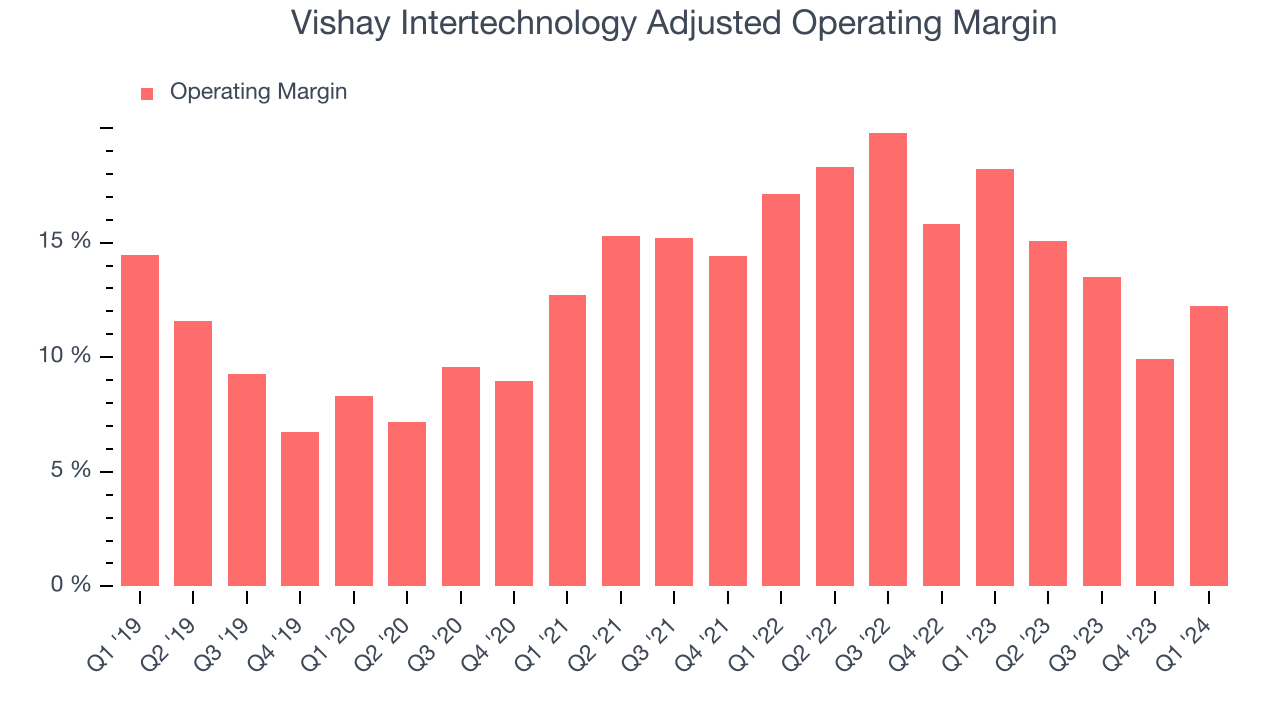
Vishay Intertechnology's operating margins have been trending down over the last year, averaging 12.9%. This is a bad sign for Vishay Intertechnology, whose margins are already below average for semiconductor companies. To its credit, however, the company's margins suggest modest pricing power and cost controls.
Earnings, Cash & Competitive Moat
Wall Street expects earnings per share to decline 10.8% over the next 12 months, although estimates will likely change after earnings.
Although earnings are important, we believe cash is king because you can't use accounting profits to pay the bills. Vishay Intertechnology's free cash flow came in at $27.88 million in Q1, down 67.1% year on year.
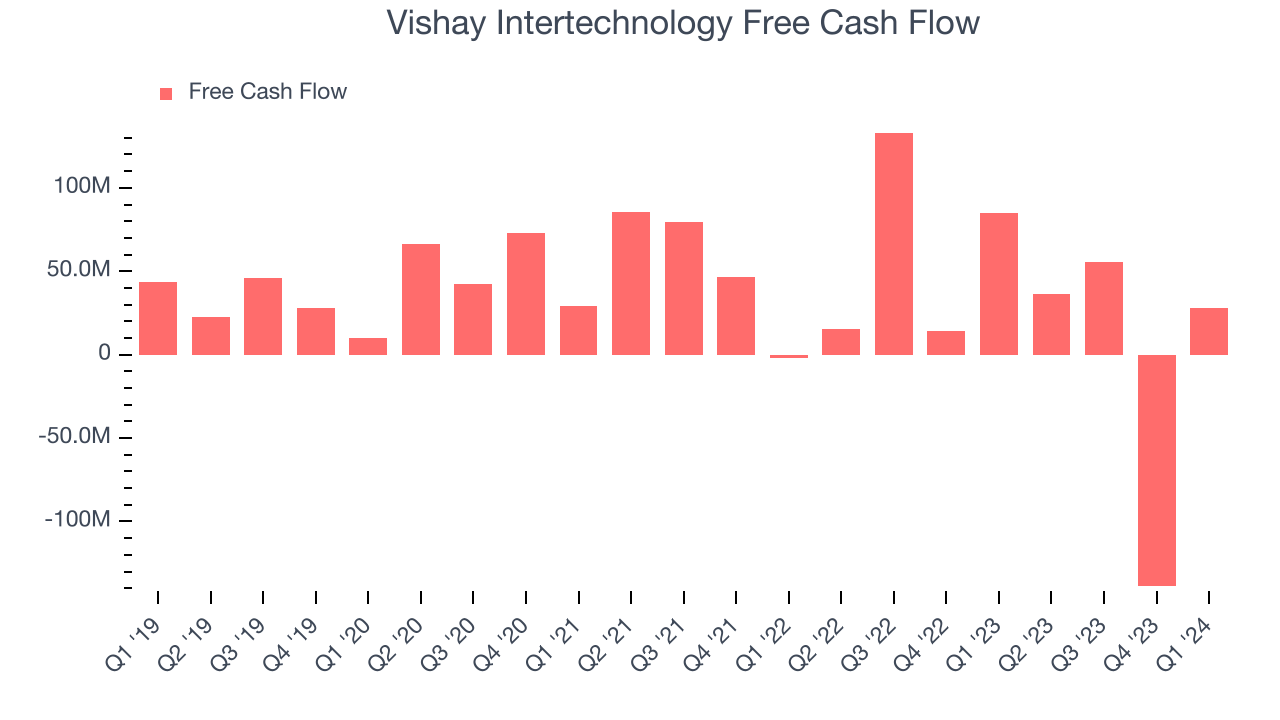
Vishay Intertechnology broke even from a free cash flow perspective over the last 12 months. This below-average FCF margin stems from Vishay Intertechnology's need to reinvest in its business to penetrate the market.
Return on Invested Capital (ROIC)
EPS and free cash flow tell us whether a company was profitable while growing revenue. But was it capital-efficient? A company’s ROIC explains this by showing how much operating profit a company makes compared to how much money the business raised (debt and equity).
Vishay Intertechnology's five-year average ROIC was 18.6%, somewhat low compared to the best semiconductor companies that consistently pump out 35%+. Its returns suggest it historically did a subpar job investing in profitable business initiatives.
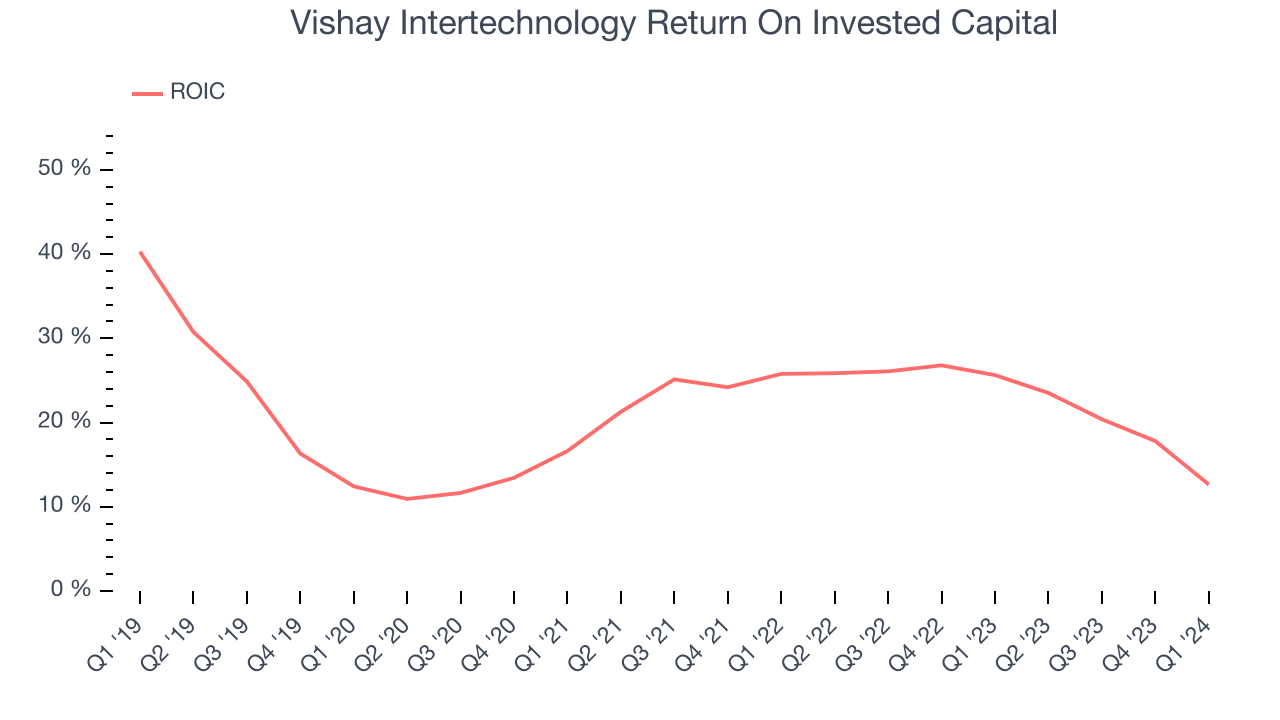
The trend in its ROIC, however, is often what surprises the market and drives the stock price. Over the last few years, Vishay Intertechnology's ROIC averaged 4.6 percentage point increases. This is a good sign, and we hope the company can continue improving.
Key Takeaways from Vishay Intertechnology's Q1 Results
It was encouraging to see Vishay Intertechnology top analysts' revenue and EPS expectations this quarter. On the other hand, its revenue guidance for next quarter missed, and the company echoed the broader semiconductor industry's sentiment surrounding inventory reduction. Like its peers, however, it expects customer inventories to correct in the back half of the year. Overall, this was a mediocre quarter for Vishay Intertechnology. The stock is flat after reporting and currently trades at $22.97 per share.
Is Now The Time?
When considering an investment in Vishay Intertechnology, investors should take into account its valuation and business qualities as well as what's happened in the latest quarter.
We cheer for everyone who's making the lives of others easier through technology, but in the case of Vishay Intertechnology, we'll be cheering from the sidelines. Its revenue growth has been uninspiring over the last three years, and analysts expect growth to deteriorate from here. On top of that, its growth is coming at a cost of significant cash burn, and its gross margin indicate some combination of pricing pressures or rising production costs.
Vishay Intertechnology's price-to-earnings ratio based on the next 12 months is 17.3x. While we've no doubt one can find things to like about Vishay Intertechnology, we think there are better opportunities elsewhere in the market. We don't see many reasons to get involved at the moment.
Wall Street analysts covering the company had a one-year price target of $22.67 per share right before these results (compared to the current share price of $22.97).
To get the best start with StockStory check out our most recent Stock picks, and then sign up to our earnings alerts by adding companies to your watchlist here. We typically have the quarterly earnings results analyzed within seconds of the data being released, and especially for the companies reporting pre-market, this often gives investors the chance to react to the results before the market has fully absorbed the information.
